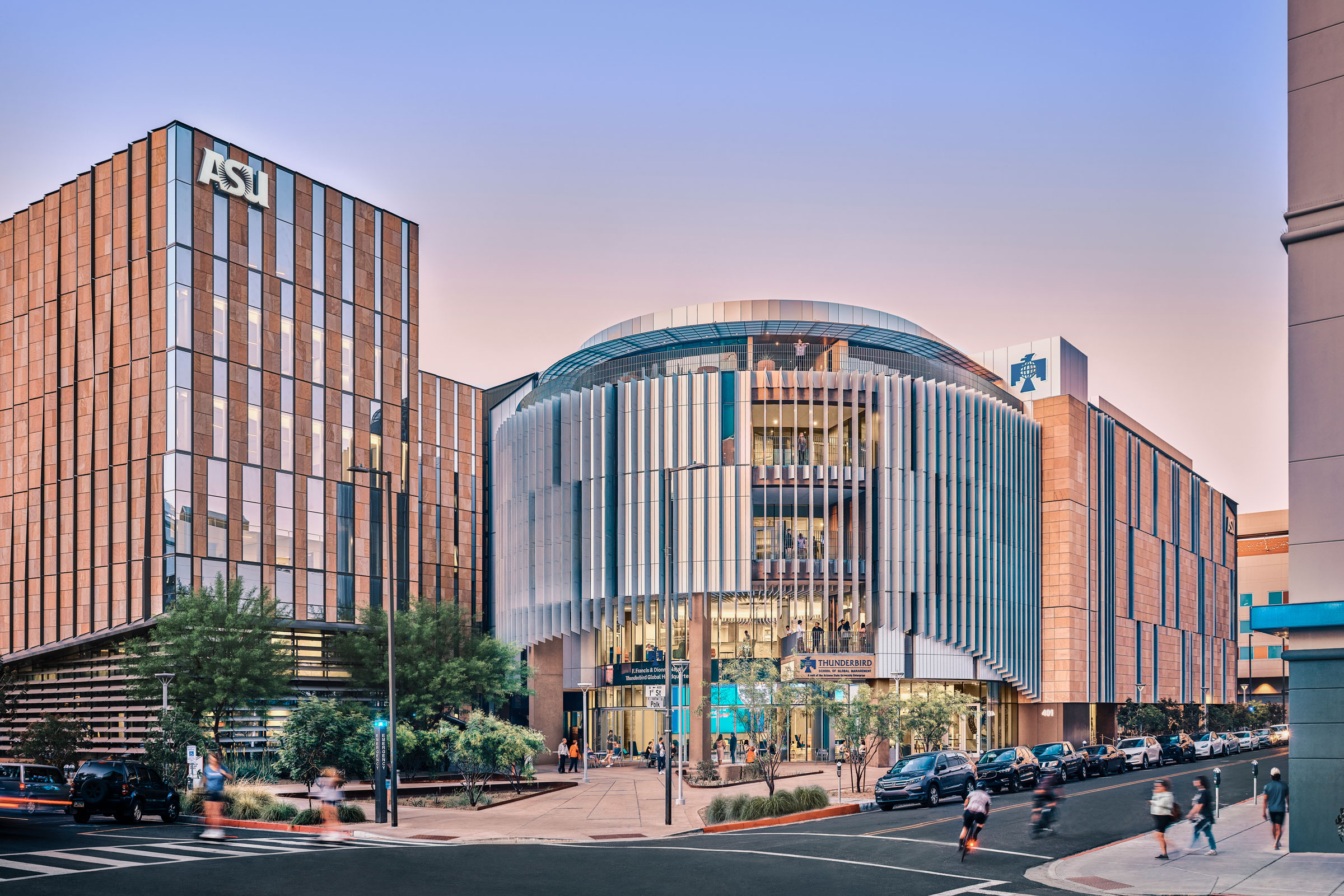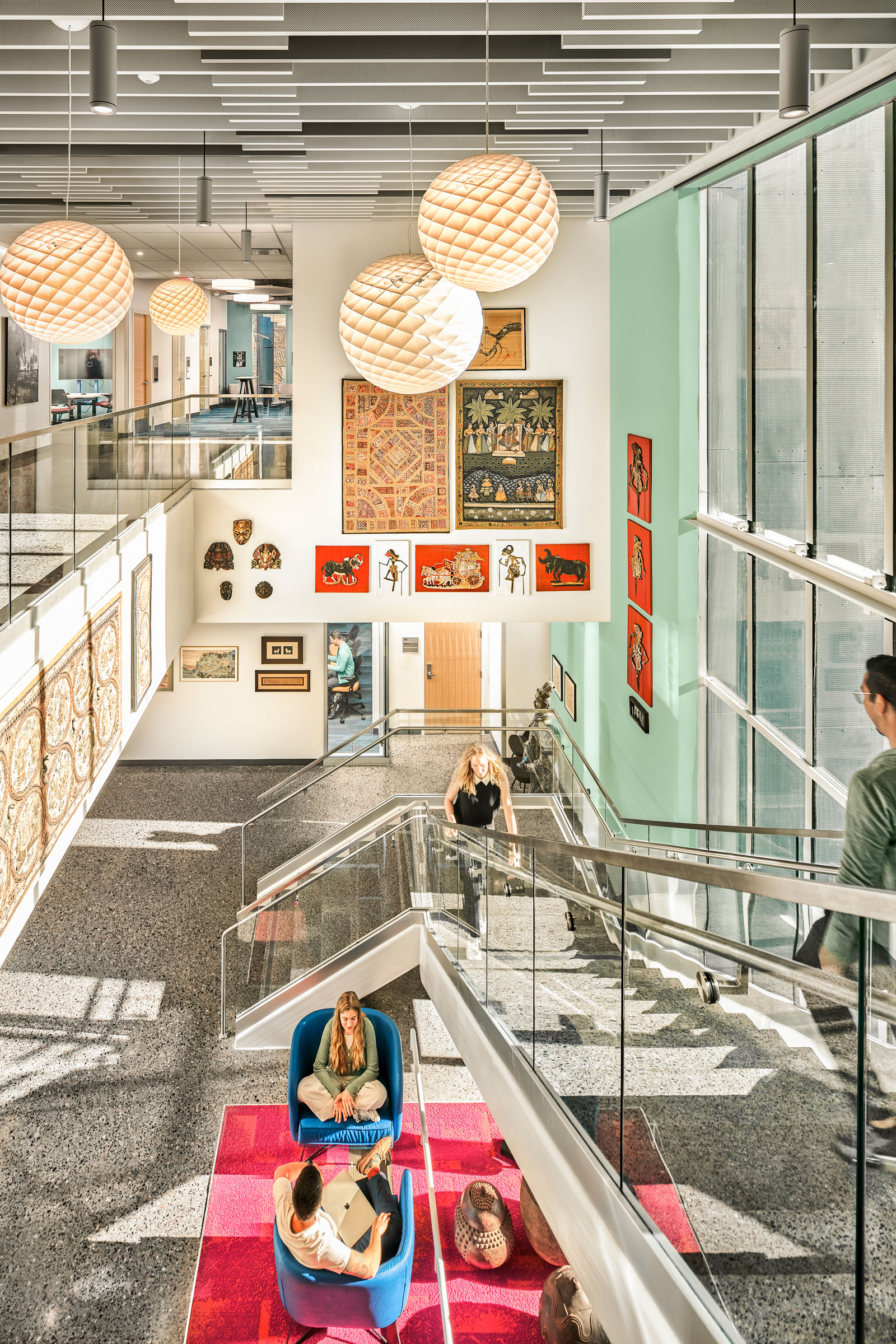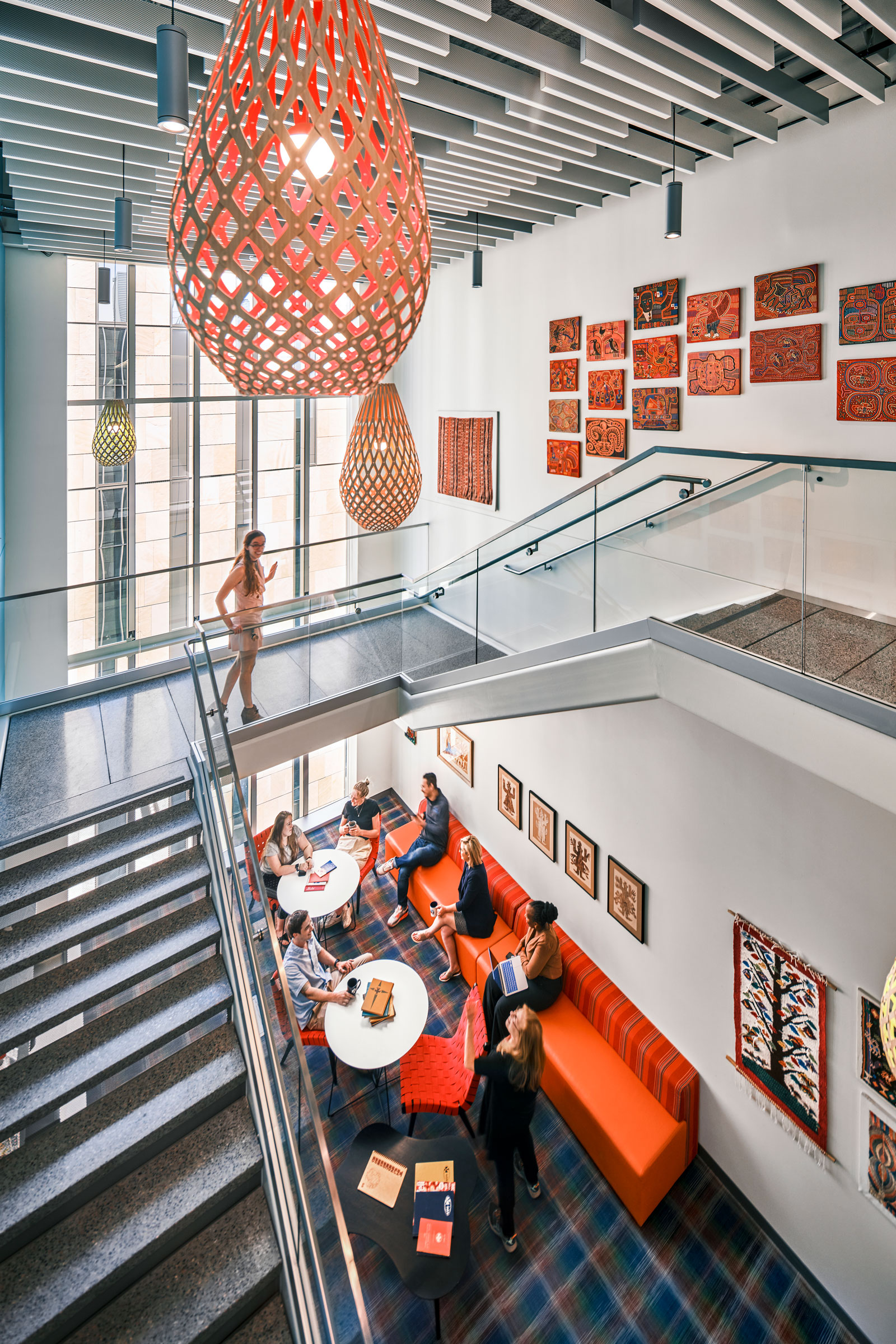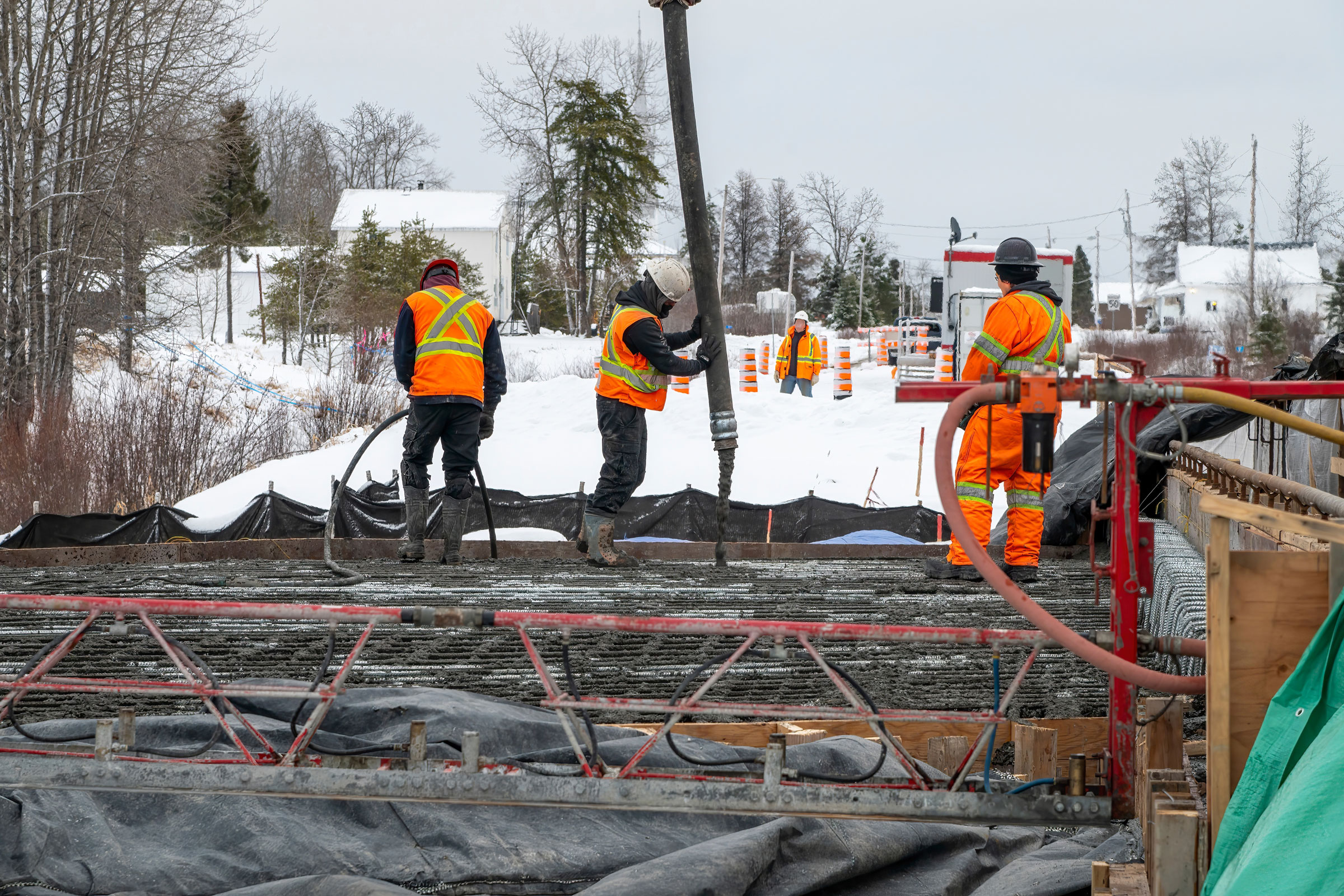Story at a glance:
- The future is being shaped inside the new Thunderbird School of Global Management at ASU.
- Moore Ruble Yudell Architects & Planners and Jones Studio designed the project to celebrate old and new.
- The facilities are equipped to evolve to meet the latest technology needs throughout the project.
The world is at the center of the new Thunderbird School of Global Management at ASU in downtown Phoenix. Quite literally, an 8-foot-wide retractable digital globe hangs from the center of a large room, surrounded by LED screens, as part of many interactive components inside the school’s Digital Global Forum.
Within the facilities students can connect with people all over the world in real time using active and multi-dimensional technologies. With a modular approach to space planning and AV and IT fit for future plug-and-play, the headquarters is prepared to adapt to short- and long-term needs. Communal gathering spaces are designed for multi-use programming, with the ability to quickly transform from a study space to collaborative work or event space.
The design teams said the building had to embody the past, present, and future while also emphasizing tech. “It was an interesting paradigm to operate in, especially when you kind of have two clients in Thunderbird and ASU and are trying to navigate the needs of both to make sure they get the architecture they need for the next 50 to 100 years,” says Shawn Swisher, an architect at Jones Studio.
Much of the Thunderbird School is open to the public. The headquarters connects the ground floor to the public realm through the two-story Digital Global Forum open rotunda event space. Plentiful daylight pours in across five floors. Dedicated learning spaces include nine flexible classrooms, two sandbox classrooms, and seven group study rooms. People can attend lectures and events in the Global Decision Theater, experience a virtual reality language lab, 1,600-square-feet of digital displays, and a green screen studio.
The History
- Louis Poulsen and David Trubridge make the round pendant light fixtures. Photo by Inessa Binenbaum
- The Knoll k. lounge bench sits in an area that celebrates Thunderbird’s with art and artifacts. Photo by Inessa Binenbaum
The building was designed to be a welcoming, inclusive space for international students, faculty, and alumni while connecting to the city. The Thunderbird School was on the verge of closing when it merged with Arizona State University and a plan was made to create a new location in downtown Phoenix. Architecture firms Moore Ruble Yudell and Jones Studio were tasked with designing the new headquarters for the Thunderbird School of Global Management. They wanted to make sure the design didn’t alienate current students and alumni, instead celebrating the old school and location while looking ahead excitedly to the future.
“Early on we said it was going to be probably the most technologically sophisticated business school—potentially in the world. It really had to be a welcoming, multicultural place,” says Buzz Yudell, partner at Moore Ruble Yudell. “It was the idea of balancing high tech with high touch, and it also had to be very much a place of Phoenix and of the region.”
The Thunderbird School of Global Management was founded after World War II with the goal to bring people from different cultures together to collaborate and study. It was an effort toward peace and understanding in a new world, and it started in a little area called Glendale on a former airbase. It was a tight-knit community, Yudell says, almost like going to camp, and students formed lifelong personal and professional relationships there.
The new school needed to be cutting edge, offering the most technically enhanced learning environment while still being inviting to neighbors. The design team wanted to honor the original campus, as alumni had been going there for almost 70 years before they had to relocate and merge with ASU to stay afloat. “How do you re-envision all of the memories and the significance of that place while also integrating it into a new home of downtown Phoenix—not closing your doors and turning your back to the city that you’re now making your new home for the future?” Swisher says.
The Latest Technology
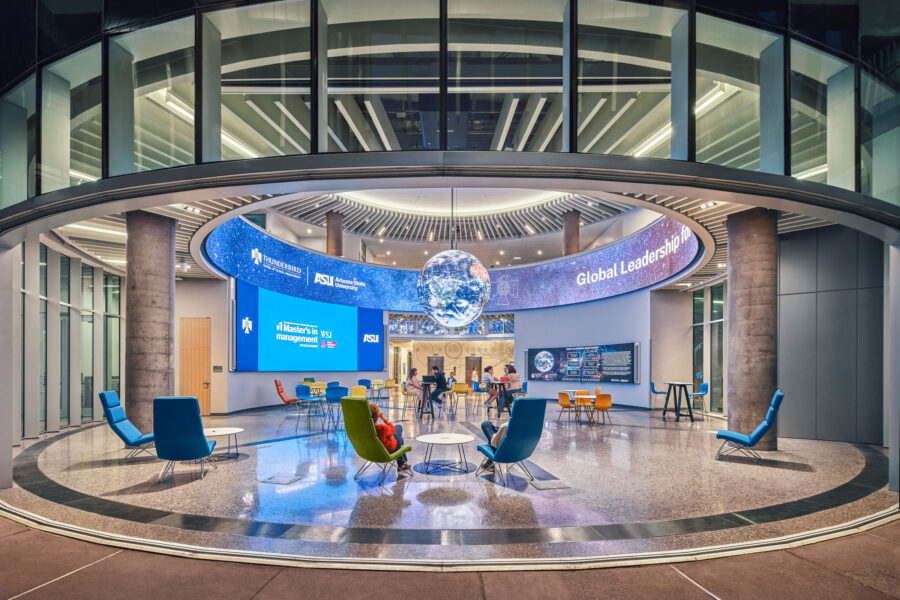
The Digital Global Forum event space features a stadium-style ring of LED video screens that forms an encircling digital presentation field, while an LED globe at the center of the rotunda plays dynamic videos. The Digital Global Forum opens to the plaza through a two-story curtain wall glazing and a nearly 40-foot wide operable partition, establishing an openness between interior and exterior. Photo by Inessa Binenbaum
Every space was designed with technology in mind. “The whole building is set up for a tremendous amount of digital technology for teaching and collaborating,” Yudell says. The Global Form is a standout example of tech in action, as students and faculty can easily call collaborators on the other side of the world and work on problems together, surrounded by a floor to ceiling digital wall. “That room has a goal of being a globally connected, immersive space,” Yudell says.
The Innovation Labs on the ground floor near the Global Forum offer more flexible space and include table-size interactive virtual reality and augmented reality tablets. “People are encouraged to experiment, move things around, and bring in new kinds of projects,” Yudell says.
He says the design teams wanted to make the technology as user friendly as possible while investing in wireless hookups to make future tech expansions easier.
Location
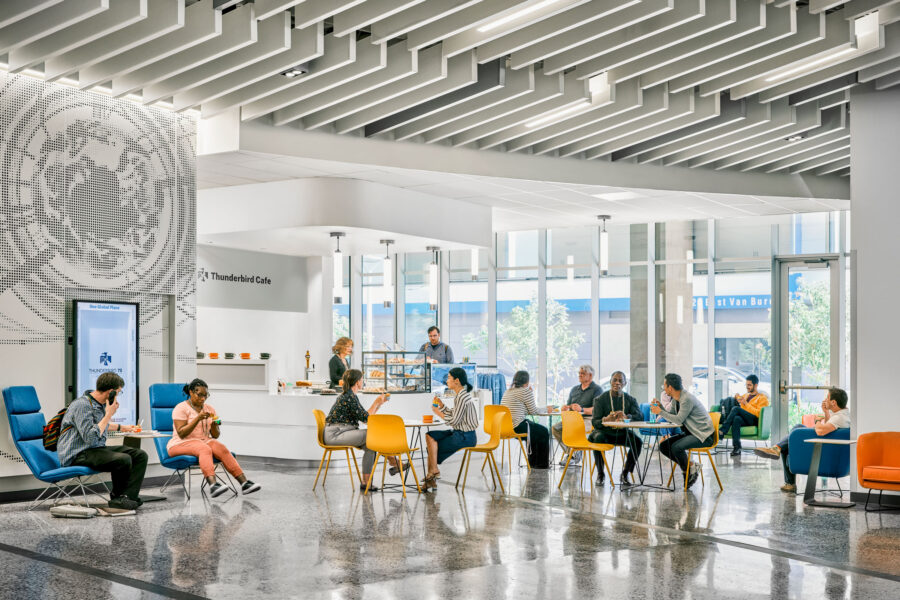
All lighting uses LED sources. Acoustic baffles by Ceilings Plus in Barz Lumin White and Standard Silver. Photo by Inessa Binenbaum
Swisher says the downtown Phoenix location helped the new headquarters connect to the business core of the city. Jones Studio completed an ASU Law School project on the same block less than 10 years before. “They carved out this little postage stamp of a site to be used for a future project, and that ended up being the Thunderbird School. There was already this existing grain of pedestrian movements and the frontage to the streets.”
This allowed the architects to capitalize on public space. “There’s very little open public space in downtown Phoenix, and the significance of that—of creating spaces where people can be part of these incredible academic institutions in the heart of downtown, we wanted to draw focus to that,” Swisher says. “We put glass on that ground level to create this transparency from the city into the school so there could be this visual connection; you could see the action happening in the school at all times, and the school could also have a connection back to the city.” He says the Global Forum is a huge example, as it has the ability to open at the ground level directly to the outdoor plaza.
“That connection to community, that connection to Phoenix while also being around technology and highlighting public space in academic institutions—all of that is threading the needle of all of those goals between ASU and Thunderbird,” Swisher says.
Planning for the Future
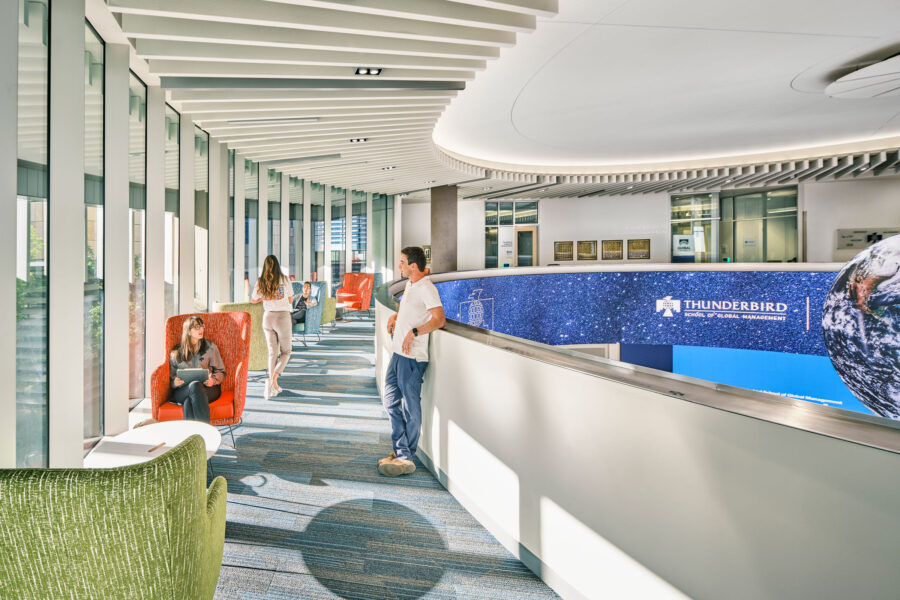
Knoll Rockwell Highback Chairs with wire bases in colorful combinations overlook views to the outside. Photo by Inessa Binenbaum
The architects knew they wanted the project to be at least a 100-year building. Part of that meant not only using robust and, where possible, local materials that were very durable but also making the building extremely flexible for years to come.
“One of the biggest missions we collectively had was to think about sustainability in the broadest, most holistic sense,” Yudell says. “We’re targeting LEED Gold, but we wanted to really think beyond the checklist of LEED or any other guidelines.” The tight site and university budget were challenges. They needed an efficient grid for the whole building. “If you look at the plan, it’s about a 38-foot structural grid across the whole building with a very simple core and very simple organization,” Yudell says.
They paid special attention not only to designing to make future implementation of tech easier but also to allow for the spaces themselves to evolve. “We can never fully predict how pedagogy or research or collaboration is going to change, but essentially everything in the building can be reconfigured within this otherwise very straightforward organizational system,” Yudell says.
He says most business schools have been adding flat-floored classrooms to their traditional tiered classrooms but still have a significant number of tiered setups. “We took a leap and said—what if everything in the building were flat-floored and every room in the building had a really robust infrastructure for AV and digital technology, and everything could be flexible, changeable, adaptable, both in the short term and long term?”
Since teaching in many schools is moving more toward active learning with collaboration and reconfigurable spaces, the design team realized they didn’t really need tiered classrooms despite their long tradition. “We can set up more traditional configurations if we want to with furniture that steps up rather than floors that step up, for example,” Yudell says. He says not doing tiered classrooms also saved the project money.
Designing in the Desert
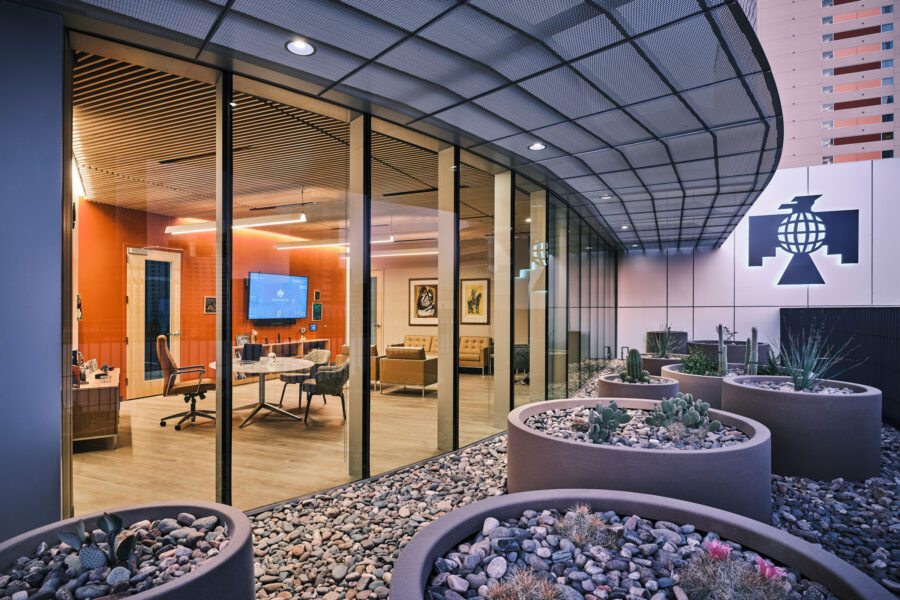
The landscape design brings the desert to downtown Phoenix by integrating habitats for birds and native pollinators in the heavily paved urban center. Native Mesquite trees pitch in with the building’s overhang to provide shade for the plaza throughout the day, creating a comfortable public space in the arid downtown. Plants were selected to minimize water use while offering abundant shading and mitigating heat island effect. Photo by Inessa Binenbaum
The new building also minimizes water and energy—vital in Phoenix’s desert environment. Materials and products were sourced locally to reduce emissions, and the design team emphasized passive design techniques.
Water and shade were important parts of the project—from low-flow fixtures to landscaping that helped to create cooler spaces. They harvest water from the roof to use in rain gardens rather than sending it straight to storm drains. “Those rain gardens are creating cooler spaces underneath deeply shaded, outdoor patio spaces,” Swisher says. Native, drought-resistant plants absorb heat while being a beautiful representation of the Sonoran Desert.
“One of the real challenges here was planning and designing in a desert environment for comfort and appropriateness of shade and materials but also for energy conservation,” Yudell says. “We were targeting a very low total amount of glazed areas—like 25%. That ended up being distributed with a great deal of transparency on the ground level and quite a lot on the roof level—which has this pub that’s a kind of recollection of the historic Glendale campus and another really important public place.” Smaller, carefully placed openings can be found all around the building, helping to further create energy-saving and provide comfortable conditions inside.
Swisher says they very intentionally recessed that storefront on the ground level 10 or 12 feet back from the building’s edge to create outdoor covered patios—almost like little living rooms. “On the southeast corner of the block there’s this small plaza that’s almost a 30-foot square that is recessed back into the building where people can sit and enjoy times of the year when it’s actually quite nice to sit outside.”
Tall, deeply recessed windows with shade fins bring more natural light deep into the interior without the glare and solar heat, too. The Global Forum space posed one of the biggest design issues, as they had to figure out how to put a big glass room on a west facing open side of the block. “We had to carve and shape the mass of the building and bring shades down to do everything we could to get that space to be comfortable,” Swisher says. “It’s performing quite well in part because we have this bridge that completes that western edge of the forum that helps keep shade in the building and keep the sun out.”
Interior Design
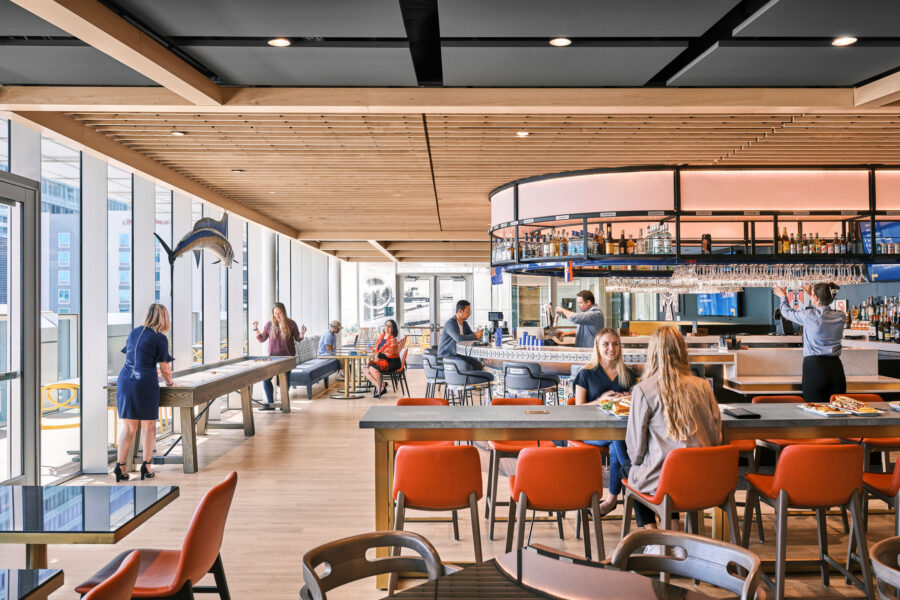
The headquarters is topped with a rooftop pub filled with artifacts from the original Thunderbird Control Tower Pub and offering views of downtown Phoenix. Photo by Inessa Binenbaum
The design teams very much wanted to honor the history of the original Thunderbird School with the design of the new building. Beautiful, two-story heritage spaces connect the floors and provide a place for students to relax during the day, surrounded by art collected from all over the world at Thunderbird.
The heritage spaces are organized by continent, with an Africa heritage space, Asia heritage space, and so forth. The colors, materials, and furnishings in each were designed to mirror the cultural expression of the artwork there. “The building is welcoming everyone as a multicultural experience and celebration of diversity, which is very important,” Yudell says.
The art, history, and tech are all working together to connect people, Swisher says. “The building uses technology to create human connection, and technology connects Thunderbird with their centers across the globe. It creates a unique and rich educational opportunity for the students of Thunderbird to connect anywhere in the world.”
That’s embodied in part with the large interactive displays, but also by the physical layout of the space, with opportunities for human connection with the community, the city of Phoenix, and opening the building to the public. “Sure, we’re looking at a bunch of screens, but those screens are the focus of this communal public space, and then that public space is reaching out to the world through technology,” Swisher says. “Those are the ways I think you start to resonate with, ‘How does the digital display really speak to innovation?’”
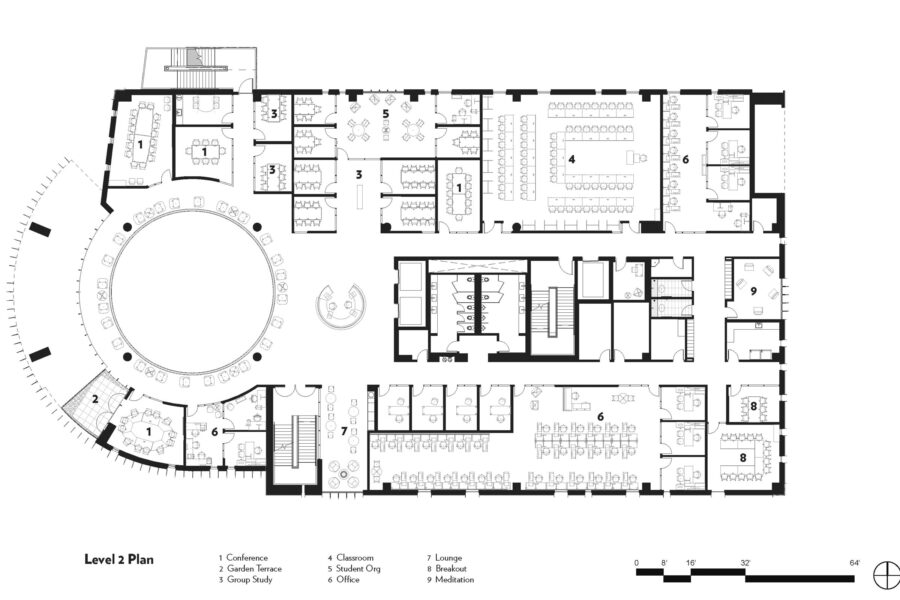
Drawing courtesy of ASU

